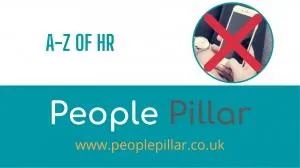Blog

R is for...
Wowzers!! Where do I even start with R in my HR A-Z. So many big hitters….
Let’s start with the obvious one – redundancy. A word that you seem to hear everywhere you turn at the moment.
If you are unfortunately considering restructuring or redundancies, here are a few pointers to consider when managing the process.
Plan, plan, plan – whilst I appreciate you need to get the process started, spending a bit of time doing your prep work and thinking things through properly will save you a lot of pain in the future (I promise).
There are lots of legal considerations in the redundancy process so do your reading and make sure you are clear on the numbers of employees you are considering, who you need to consult with and for how long, redundancy pay calculations, alternative positions to avoid redundancy etc. If you are unsure then ask for help to avoid the unnecessary cost later on of getting it wrong.
Redundancy can be really hard both for the employee and the manager leading the process. Be considerate, supportive, communicate well and whilst working from home might make things tricky, definitely don’t do it by text.
I hope that helps but redundancy is a complex one so if you have any questions, send me a message.
Reasonable adjustments
Did you know that small businesses need to consider making reasonable adjustments when:
• an employee or job applicant has a disability
• an employee or job applicant with a disability asks for adjustments
• an employee with a disability is struggling with any part of their job
• an employee’s absence record, sickness record or delay in returning to work is because of or linked to their disability
An employer also needs to consider making adjustments for anything linked to a disability as long as it’s reasonable. An obvious example, could be allowing a guide dog into the workplace to assist someone who is blind.
A less obvious one could be giving someone who is dyslexic more time at an interview if it involves a written exercise.
So what exactly does reasonable mean?
An employer needs to think about:
• the practicality of making the adjustment
• the cost of the adjustment
• resources available and size of the business
• the availability of financial support
• how effective the change will be in removing, reducing or preventing the disadvantage
Every business is different so any reasonable adjustments will need to be made on the individual circumstances.
Ultimately though the aim is to remove or reduce any substantial disadvantage that a disabled person may experience in recruitment or within the workplace.
Employers should use every opportunity to ask their employees whether they need any adjustments. This can be done through one to one meetings, appraisals and when staff return to work from absence.
But what about the cost?
As crazy as it sounds, cost shouldn’t be the main consideration in making a decision about whether an adjustment is reasonable or not. Most reasonable adjustments cost less than £100, whilst many will cost nothing at all and simply require a change to a process or a policy.
Where costs are higher, Access to Work can help through reimbursing the costs of equipment, any adaptations that are needed or for support worker services.
If you have a question about reasonable adjustments, get in touch today.
I haven't covered recruitment, right to work guidelines or resignations so give me a shout if you would like to find out more.
If you find this article useful, consider sharing it with others.
Happy Customers

Say Hello

©2021 - 2024 People Pillar HR | Privacy Policy

